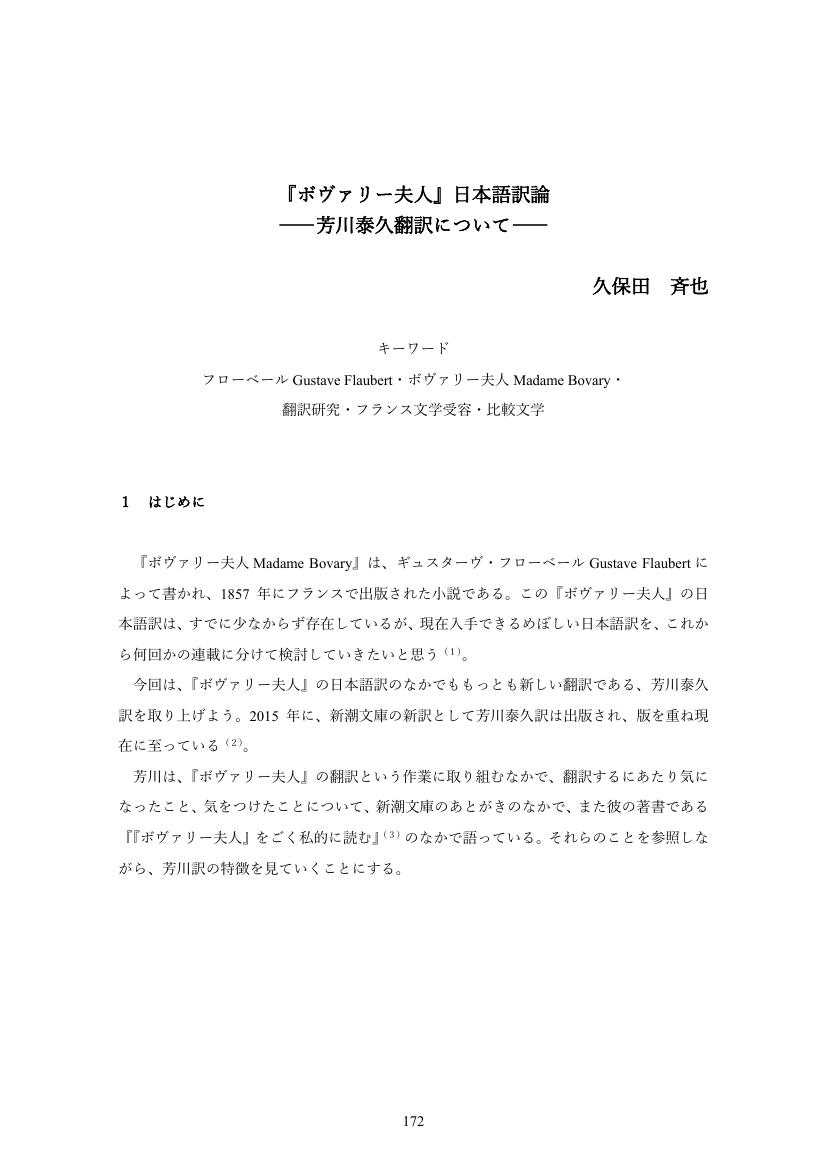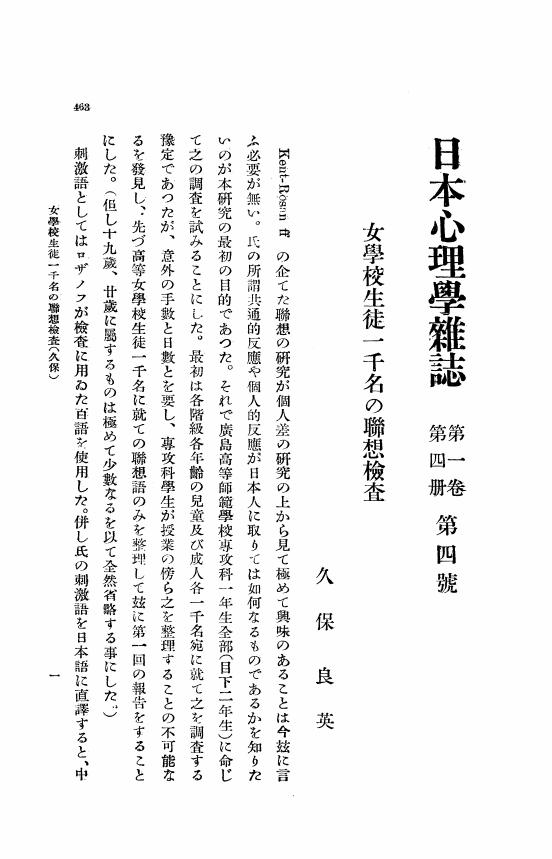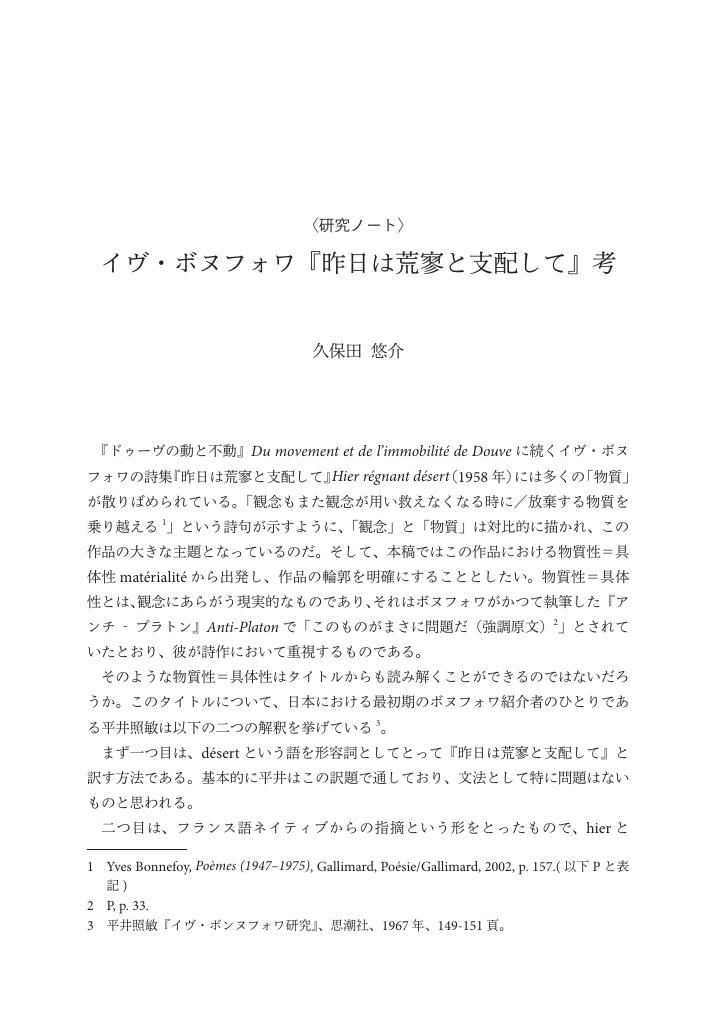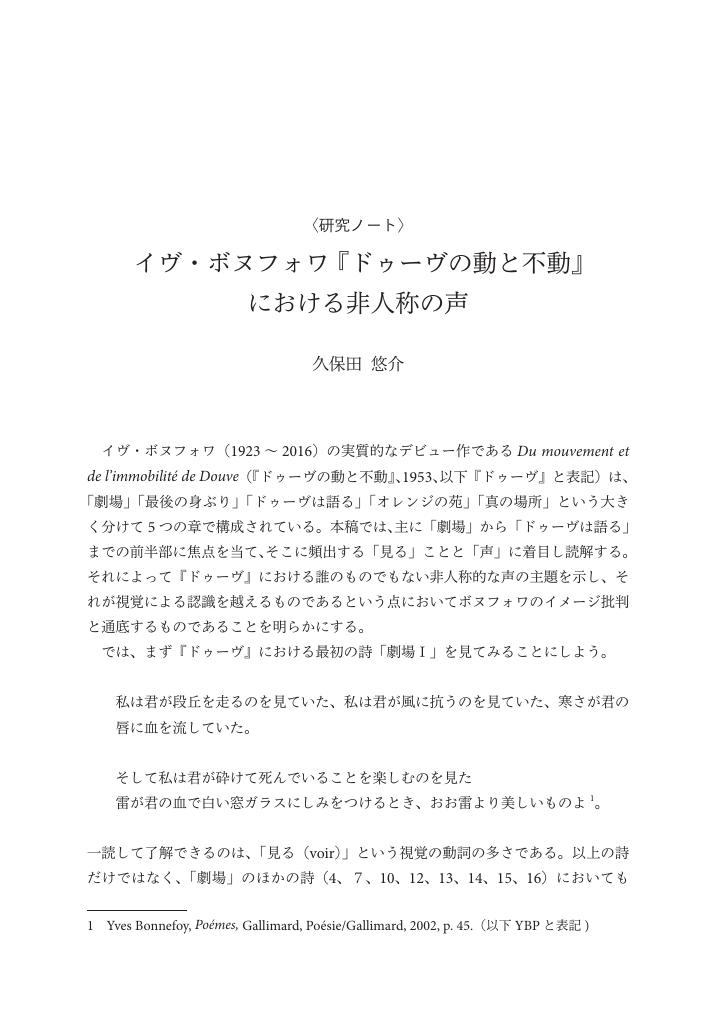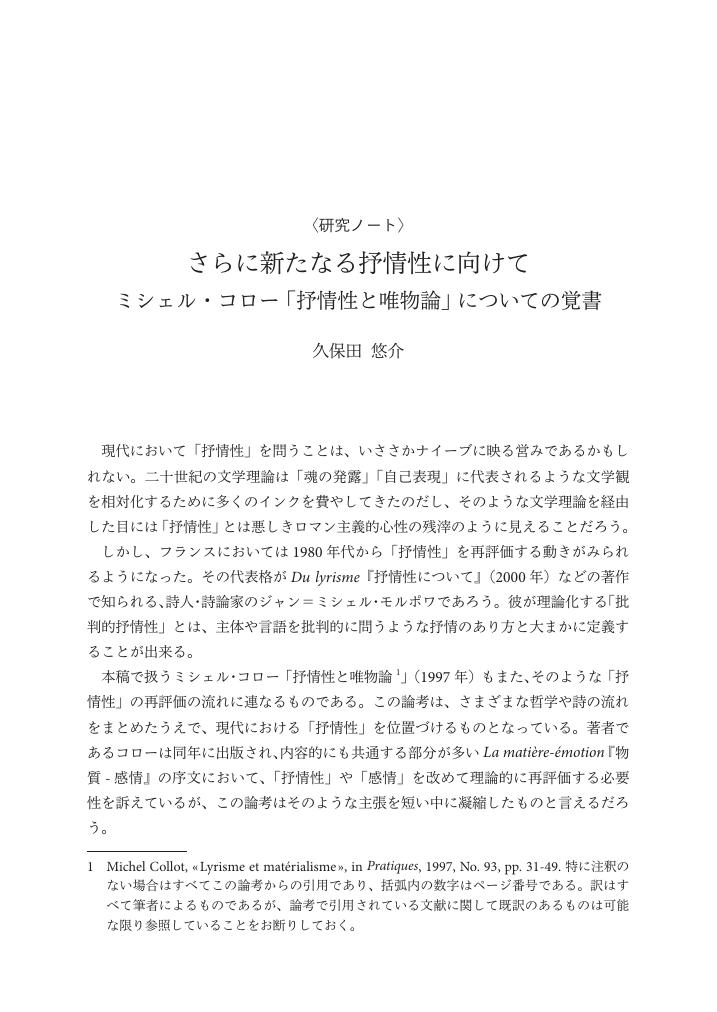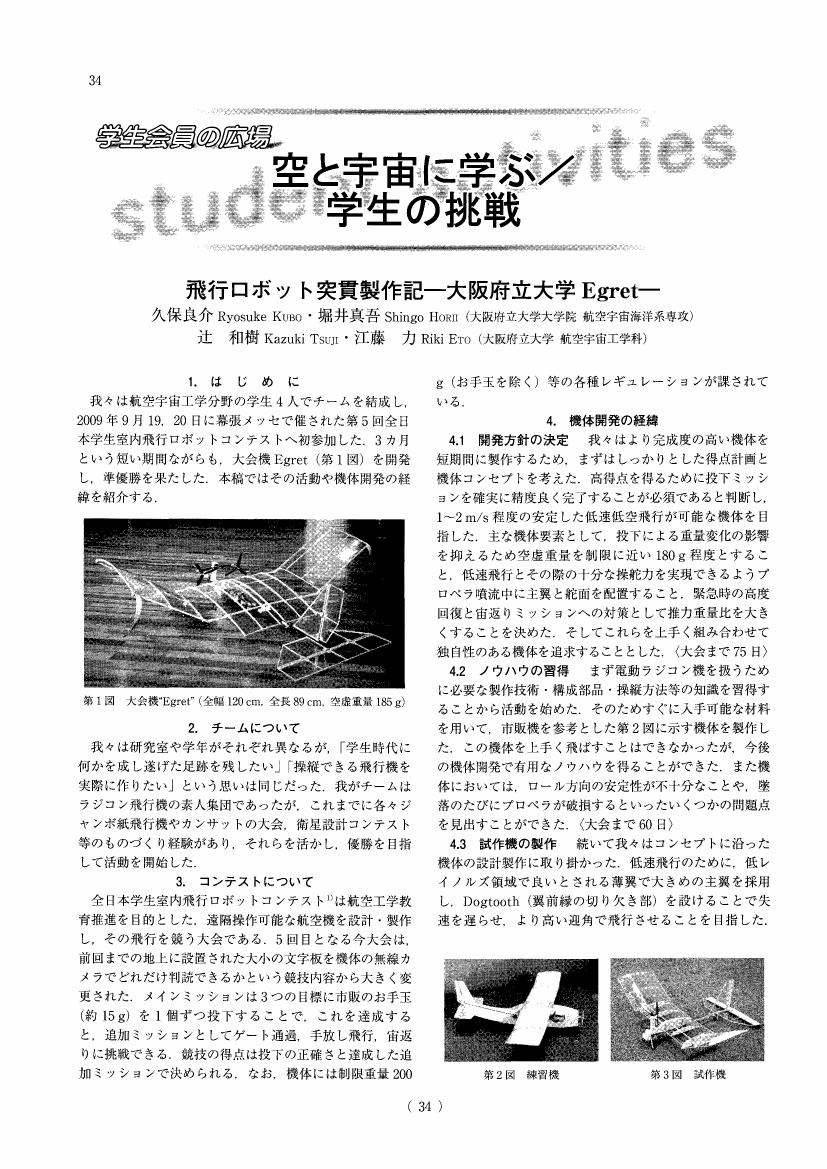1 0 0 0 OA 津田眞道の著作に就て (二) (昭和十九年六月十二日報告)
- 著者
- 大久保 利謙
- 出版者
- 日本学士院
- 雑誌
- 帝國學士院紀事 (ISSN:03879984)
- 巻号頁・発行日
- vol.4, no.1, pp.17-47, 1946 (Released:2007-05-30)
1 0 0 0 OA 西周の歴史觀 百學連環に於ける歴史の問題 (昭和十八年四月十二日報告)
- 著者
- 大久保 利謙
- 出版者
- 日本学士院
- 雑誌
- 帝國學士院紀事 (ISSN:03879984)
- 巻号頁・発行日
- vol.2, no.2, pp.207-236, 1943 (Released:2007-05-30)
1 0 0 0 OA 満蒙政策と政友会 大正期における野田卯太郎と山本条太郎
- 著者
- 久保田 裕次
- 出版者
- 日本史研究会
- 雑誌
- 日本史研究 (ISSN:03868850)
- 巻号頁・発行日
- vol.666, pp.131-158, 2018 (Released:2022-02-28)
1 0 0 0 OA 子どもの生活時間の趨勢(1970-2020)
- 著者
- 大久保 心
- 出版者
- 日本時間学会
- 雑誌
- 時間学研究 (ISSN:18820093)
- 巻号頁・発行日
- vol.12, pp.31-51, 2021 (Released:2022-07-01)
生活時間研究を通じて,子どもの日常生活の階層間格差や地域間格差,特定の行動の時系列変化が明らかにされてきたが,子どものライフスタイルの総合的な趨勢の検討は十分でなかった。そこで本稿は,子どものライフスタイルの変化と安定の傾向を長期的に把握することを目的とした。10歳以上を対象とした「国民生活時間調査」の小学生,中学生,高校生,および親世代の40代の集計データを用いて,1970年から2020年までの時間量とタイミングの情報から生活時間の時系列変化を確認した。その結果,夜帯の生活時間の時系列変化について,40代と小学生は連動しやすい傾向が見られた一方で,中高生は40代と独立した傾向が見られた。また,日中の生活時間の多様性について,平日は50年間かなり安定していたが,日曜では一貫した変化と安定の傾向は見られなかった。平日と日曜の夜帯について,どの年齢層でも長期にわたり行動の多様化が見られたが,40代と小学生は徐々に夜型化していたのに対して,中高生は夜型傾向の維持と同時に自由行動の増加が確認された。以上の結果から,生活時間データからライフスタイルを捉える場合に時間量とタイミングの両情報の利用が有効であること,生活時間研究が子どもの社会化を長期的かつ客観的に把握するために重要であることが示された。
1 0 0 0 OA 『ボヴァリー夫人』日本語訳論 芳川泰久翻訳について
- 著者
- 久保田 斉也
- 出版者
- アジア・文化・歴史研究会
- 雑誌
- アジア・文化・歴史 (ISSN:24239461)
- 巻号頁・発行日
- vol.13, pp.151-172, 2022 (Released:2022-03-01)
1 0 0 0 OA 女學校生徒一千名の聯想檢査
- 著者
- 久保 良英
- 出版者
- 公益社団法人 日本心理学会
- 雑誌
- 日本心理学雑誌 (ISSN:18841074)
- 巻号頁・発行日
- vol.T1, no.4, pp.463-514, 1923-12-01 (Released:2010-07-16)
1 0 0 0 OA 戦争の中の観光 松本清張『象の白い脚』
- 著者
- 久保田 裕子
- 出版者
- 昭和文学会
- 雑誌
- 昭和文学研究 (ISSN:03883884)
- 巻号頁・発行日
- vol.75, pp.70-82, 2017 (Released:2022-07-01)
1 0 0 0 OA 日本の政治体制、政治機構、政治方法、政治原則および憲法の性格
- 著者
- 久保 憲一
- 出版者
- 関西法政治学研究会
- 雑誌
- 憲法論叢 (ISSN:24330795)
- 巻号頁・発行日
- vol.4, pp.23-44, 1997-12-18 (Released:2018-01-10)
In this paper. I have attempted to classify and compare the special features of British, American and Japanese political systems. By ascertaining our 'national character' This paper is hoped to contribute to the way our country ought to be.
1 0 0 0 OA 天皇規定に関する学界の固定観念
- 著者
- 久保 憲一
- 出版者
- 関西法政治学研究会
- 雑誌
- 憲法論叢 (ISSN:24330795)
- 巻号頁・発行日
- vol.1, pp.25-36, 1994-04-15 (Released:2018-01-10)
A number of scholars of the Japanese Constitutional Law believe that status of Japanese Emperor was demoted from the head of the Empire (combining in Himself the rights of sovereignity) to the symbol of the State and of the people after the defeat in the World War II. I disagree with this perspective. Because it is based on old formula and traditional definition of monarchy, it is an obsolate point of view. The purpose of this paper is to substantiate my disagreement with the above conception.
1 0 0 0 OA 早期診断・再灌流療法に成功したWellens症候群の3症例
- 著者
- 石野 光則 池野 栄一郎 鈴木 智隆 竹村 昭宣 北原 辰郎 新関 武史 山内 聡 久保田 功
- 出版者
- 公益財団法人 日本心臓財団
- 雑誌
- 心臓 (ISSN:05864488)
- 巻号頁・発行日
- vol.47, no.8, pp.993-999, 2015 (Released:2016-08-15)
- 参考文献数
- 5
症例1 : 高血圧, 糖尿病, 喫煙歴のある87歳, 男性. 繰り返す安静時胸痛のため近医を受診し, 不安定狭心症の疑いあり当院へ紹介された. 前医ではわずかであった心電図でV2−4誘導の2相性T波は当院ではより顕著になっていた. 症例2 : 高血圧, 脂質異常症のある61歳, 男性. 胸痛のため近医を受診し, 心電図変化あり不安定狭心症のため当院へ紹介された. 前医で認めていたV2−4誘導で2相性T波変化が当院では消失していた. 症例3 : 高血圧, 脂質異常症のある62歳, 男性. 安静時胸痛のため当院を受診した. 症状は消失していたが心電図でV2−3誘導に2相性T波の陰転化あり入院した. 入院後の胸痛時にはT波の変化は消失し, 翌朝にはV2−3誘導に2相性T波の陰転化がさらに深くなっていた. 3症例とも緊急冠動脈造影を行い, 左前下行枝近位部に高度狭窄を認め同部位へ治療を行った. Wellens症候群とは不安定狭心症の中で, 胸痛を一度自覚した後の症状が消失した時間帯に前胸部誘導でT波に心電図変化を示す症候群である. その心電図変化は症状の消失した時間帯に変化をきたすため見過ごされることが多い. 胸痛を初診する可能性のある医師に対しての本疾患の周知・啓蒙を行っていくことの重要性を感じたため報告をする.
1 0 0 0 OA イヴ・ボヌフォワ『昨日は荒寥と支配して』考
- 著者
- 久保田 悠介
- 出版者
- 『人文×社会』編集委員会
- 雑誌
- 人文×社会 (ISSN:24363928)
- 巻号頁・発行日
- vol.1, no.4, pp.97-108, 2021-12-15 (Released:2021-12-19)
1 0 0 0 OA イヴ・ボヌフォワ『ドゥーヴの動と不動』における非人称の声
- 著者
- 久保田 悠介
- 出版者
- 『人文×社会』編集委員会
- 雑誌
- 人文×社会 (ISSN:24363928)
- 巻号頁・発行日
- vol.1, no.3, pp.143-150, 2021-09-30 (Released:2021-10-04)
1 0 0 0 OA さらに新たなる抒情性に向けて ミシェル・コロー「抒情性と唯物論」についての覚書
- 著者
- 久保田 悠介
- 出版者
- 『人文×社会』編集委員会
- 雑誌
- 人文×社会 (ISSN:24363928)
- 巻号頁・発行日
- vol.1, no.2, pp.143-157, 2021-06-15 (Released:2021-06-18)
1 0 0 0 OA 文化多様性と持続可能な開発 ―複数の「開発」概念の統合問題を中心に―
- 著者
- 久保庭 慧
- 出版者
- 世界法学会
- 雑誌
- 世界法年報 (ISSN:09170421)
- 巻号頁・発行日
- vol.38, pp.55-77, 2019-03-28 (Released:2022-06-06)
1 0 0 0 OA 飛行ロボット突貫製作記 大阪府立大学Egret
- 著者
- 久保 良介 堀井 真吾 辻 和樹 江藤 力
- 出版者
- 一般社団法人 日本航空宇宙学会
- 雑誌
- 日本航空宇宙学会誌 (ISSN:00214663)
- 巻号頁・発行日
- vol.58, no.672, pp.34-35, 2010-01-05 (Released:2019-04-19)
- 参考文献数
- 2
- 著者
- 川久保 篤志
- 出版者
- 公益社団法人 日本地理学会
- 雑誌
- 地理学評論 Series A (ISSN:18834388)
- 巻号頁・発行日
- vol.90, no.6, pp.607-624, 2017-11-01 (Released:2022-03-02)
- 参考文献数
- 32
本稿は,GATTウルグアイラウンド合意によって米国からミニマムアクセス米が輸入され始めて20年以上経過した現在の米国の米需給と産地の動向を検討したものである.その結果,対日輸出基地であるカリフォルニア州では,①国内外市場の拡大で史上最高レベルの生産量と収益性を維持していること,②水利条件の制約で現在以上に栽培面積を拡大できないこと,③生産の中心は中粒米で,日本食ブーム下でも短粒米市場は拡大していないこと,④短粒米の中でも日本品種は栽培が難しく低収量なため積極的な栽培はみられないこと,が明らかになった.つまり,現在の米国では米の輸出圧力は小さく,かつ日本市場に合う短粒米の増産は期待できないので,現状の管理貿易の維持が米国にとっても最善の策であると考えられる.
1 0 0 0 OA 齊藤 孝祐 著『軍備の政治学 ――制約のダイナミクスと米国の政策選択』
- 著者
- 久保田 ゆかり
- 出版者
- 国際安全保障学会
- 雑誌
- 国際安全保障 (ISSN:13467573)
- 巻号頁・発行日
- vol.45, no.3, pp.55-59, 2017-12-31 (Released:2022-04-01)
1 0 0 0 OA 日本の防衛調達の制度疲労と日米関係 ―日米防衛産業の比較制度分析―
- 著者
- 久保田 ゆかり
- 出版者
- 国際安全保障学会
- 雑誌
- 国際安全保障 (ISSN:13467573)
- 巻号頁・発行日
- vol.38, no.2, pp.47-66, 2010-09-30 (Released:2022-04-14)
- 著者
- 久保田 裕次
- 出版者
- 一般財団法人 日本国際政治学会
- 雑誌
- 国際政治 (ISSN:04542215)
- 巻号頁・発行日
- vol.2022, no.205, pp.205_108-205_123, 2022-02-04 (Released:2022-03-31)
- 参考文献数
- 83
This article reconsiders Japanese diplomacy towards China during the period of the initial establishment of the Hara Takashi cabinet, concentrating on the problem of having industrial loans included in the formation of the “New Four-Power Consortium”.Previous research has concentrated on the transition from “Old Diplomacy” to “New Diplomacy”, and has stated that the Hara cabinet altered the policy of the previous Terauchi Masatake cabinet. Compared with the old consortium, the new consortium is characterised by the inclusion of industrial loans in its scope of business. However, this has only been pointed out by a few researchers, who have clarified the relationship between this problem and “New Diplomacy”. My research concentrates on the domestic preparation for participating in the new consortium, and the changes it brought to Anglo-Japanese relations.In October 1918, the Hara cabinet decided not to supply loans that would pose an obstacle to North-South peace in China, such as the “Nishihara Loans”. This decision was certainly ground-breaking, but the Army Ministry demanded certain exceptions.The US government tried to restrain Japanese economic influence on the Chinese government and proposed forming a new consortium. The US State Department insisted that the new consortium should include not only administrative loans, but industrial loans. The British government and the Hongkong and Shanghai Banking Corporation had been opposed to including industrial loans when the Six-Power Consortium was formed in 1912. The Japanese government expected that the British government and bankers would be opposed to including industrial loans this time as well. However, the British government pledged “exclusive support” to the British syndicate to unify British banks connected to China. Therefore, the Japanese government could not expect the British party to state its opposition.J. J. Abbott, an American banker who had visited Japan, had held talks with Prime Minister Hara and Deputy Foreign Minister Shidehara Kijuro. Abbott and the State Department were optimistic that Japan would want to include industrial loans. T. W. Lamont, representing the American syndicate, suggested in the inter-group conference in Paris that the new consortium should include not only administrative loans but industrial loans. Yokohama Specie Bank, representing the Japanese syndicate, agreed to his proposal. However, the bank’s stance did not represent all Japanese banks closely related to China. These banks could not fully agree to his proposal because the Hara cabinet had not yet made preparations to organize a syndicate formed of multiple banks. It was only after the Paris conference that the Hara cabinet assembled eighteen banks in Tokyo and Osaka to let them participate in the new consortium.In conclusion, it was not difficult for the Hara cabinet to agree to include industrial loans in the process of forming the new consortium. However, the Hara cabinet had not been able to organize the Japanese syndicate. The argument is also advanced that the Japanese syndicate formed by the Hara cabinet had its origins in the syndicate under the Terauchi cabinet.
- 著者
- 久保田 雅則
- 出版者
- 一般財団法人 日本国際政治学会
- 雑誌
- 国際政治 (ISSN:04542215)
- 巻号頁・発行日
- vol.2022, no.205, pp.205_124-205_140, 2022-02-04 (Released:2022-03-31)
- 参考文献数
- 62
The nuclear non-proliferation norm, or the limitation on the number of nuclear weapon states, has been institutionalized in the Nuclear Non-proliferation Treaty (NPT) centered regime. It is notable that the 25 years term limitation of the treaty was extended indefinitely and the International Atomic Energy Agency inspection system strengthened in spite of the unfairness of the treaty. Why then, was the non-proliferation norm institutionalized in such a strong regime beyond the merely ideological norm?Existing research points to the Great Powers preference and/or civil society movements as the factors behind the norm institutionalization. In contrast, this paper focuses on the norm violations and presents a hypothesis that the norm violations prompted the institutionalization of the nuclear non-proliferation norm. Specifically, the norm violations, that is, possession of nuclear weapons, gave policy makers accurate information about the costs and effects of nuclear weapons. Subsequently, many states who renounced nuclear weapon possession created the strong regime in order to bind other potential norm violators.The theoretical kernel of this argument is the uncertainty of the costs and effects of nuclear weapons. Many policy makers were not well-informed about the effects and costs after the first atomic bomb was introduced. This discouraged policy makers from planning nuclear weapon policies, then dampened their resolve to establish the nuclear non-proliferation regime. Against this background, nuclear non-proliferation norm violations, that is, new nuclear weapon possessors emerged, which reduced the uncertainty around the nuclear weapons and decisively influenced the institutionalization of the nuclear non-proliferation norm.This paper derived the hypothesis from theoretical consideration. Policy makers faced a range of uncertainties regarding nuclear weapons, including deterrent effect, costs, international relations, and normative behavior of other states. These played a role in their decisions regarding compliance with the norm. The uncertainties of nuclear weapons are reduced and the policy makers clearly recognize the costs and effects of nuclear weapons when the nuclear non-proliferation norm violations occurred. Almost all policy makers renounce possession of nuclear weapons because of their relatively high costs. They then want to bind others to abandon the aspiration for nuclear weapons. Hence it follows that a strict institution is created.The sections which follow the theoretical consideration empirically verify the above hypothesis. The third section posits that no violations led a weak institution, that is to say the 1968 NPT. The fourth section shows that the policy makers who became informed about the costs and effects of nuclear weapons by norm violations, renounced possession of nuclear weapons and strengthened the nuclear non-proliferation regime to bind other states.



